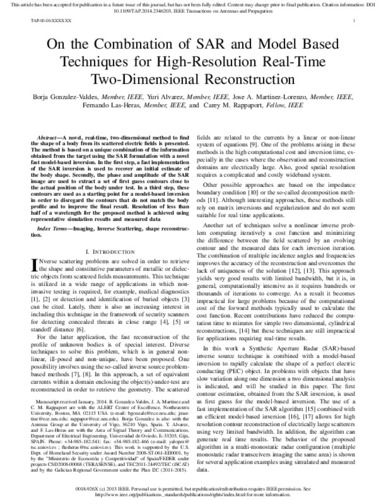On the combination of SAR and model based techniques for high-resolution real-time two-dimensional reconstruction
Fecha de publicación:
Editorial:
IEEE
Versión del editor:
Citación:
Descripción física:
Resumen:
A novel, real-time, two-dimensional method to find the shape of a body from its scattered electric fields is presented. The method is based on a unique combination of the information obtained from the target using the SAR formulation with a novel fast model-based inversion. In the first step, a fast implementation of the SAR inversion is used to recover an initial estimate of the body shape. Secondly, the phase and amplitude of the SAR image are used to extract a set of first guess contours close to the actual position of the body under test. In a third step, these contours are used as a starting point for a model-based inversion in order to disregard the contours that do not match the body profile and to improve the final result. Resolution of less than half of a wavelength for the proposed method is achieved using representative simulation results and measured data
A novel, real-time, two-dimensional method to find the shape of a body from its scattered electric fields is presented. The method is based on a unique combination of the information obtained from the target using the SAR formulation with a novel fast model-based inversion. In the first step, a fast implementation of the SAR inversion is used to recover an initial estimate of the body shape. Secondly, the phase and amplitude of the SAR image are used to extract a set of first guess contours close to the actual position of the body under test. In a third step, these contours are used as a starting point for a model-based inversion in order to disregard the contours that do not match the body profile and to improve the final result. Resolution of less than half of a wavelength for the proposed method is achieved using representative simulation results and measured data
Patrocinado por:
U.S. Department of Homeland Security [2008-ST-061-ED0001]; Ministerio de Economia y Competitividad of Spain/FEDER [CSD2008-00068, TEC2011-24492/TEC]; Galician Regional Government under Plan I2C
Colecciones
Ficheros en el ítem




